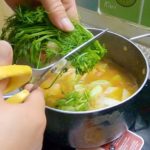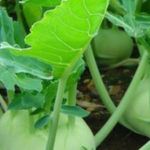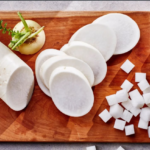Turnips are a flavorful and nutritious vegetable that is good for your health. Turnips are divided into two types, white turnips and green turnips. Green turnips contain many vitamins, minerals, and nutrients such as fiber, protein, calcium, potassium, iron… which help treat cough, phlegm, detoxify, protect the liver, and cure many diseases.
In addition to familiar dishes such as turnip salad, pickled turnips… you can also cook egg and turnip soup using the simple recipe below.
1. Ingredients for egg and turnip soup
– Green turnips
– Eggs
– Tomatoes
– Garlic, ginger, scallions
– Seasonings: MSG, sesame oil, pepper, salt

2. How to cook egg and turnip soup
Step 1: Prepare the ingredients
– After buying the green turnips, wash them and remove the skin, then slice them into thin strips. If you don’t want to slice the turnips, you can use a vegetable shredder to save time.
– Wash the tomatoes and soak them in boiling water for about 1 minute for easy peeling. After peeling off the outer skin of the tomatoes, dice them into small pieces and put them in a separate bowl.
– Soak the ginger in water until it becomes soft, then remove it from the water.
– Remove any damaged or wilted leaves from the scallions, wash them, and chop them into small pieces.
– Peel the garlic, wash it, and mince it.
Step 2: Fry the eggs
– Place a pan on the stove, add a little cooking oil and heat it up.
– Then, add the eggs to the pan and fry them until they are evenly cooked on both sides, then remove them to a bowl.

Step 3: Stir-fry the turnips with the eggs
– You continue to use the pan where you fried the eggs, add minced garlic and stir-fry until fragrant.
– Then, add the diced tomatoes to stir-fry until soft, then season with a little MSG, 1 teaspoon of salt according to the taste of your family.
– Stir until the tomatoes are soft, then add the sliced turnips and stir-fry together.
Step 4: Cook the egg and turnip soup
– Wait until the tomatoes and turnips are almost cooked, then add the fried eggs to the pan.
– Pour in another bowl of filtered water, cover the pan and simmer the soup over high heat for about 10 minutes.
– When the soup boils and the water in the pan is reduced, add sesame oil, pepper, soaked ginger, and chopped scallions, then turn off the heat.
After the egg and turnip soup is finished, it will have a very eye-catching color with the green of the turnips combined with the yellow of the eggs and the red of the ginger. When eating, you will feel the sweet and tender turnips, the rich and creamy fried eggs, and the mild sourness from the tomatoes. You can eat the egg and turnip soup with white rice.

3. Notes when cooking egg and turnip soup
– Because green turnips have a stronger and spicier taste than white turnips, you need to stir-fry them before cooking to remove these flavors, making the dish more delicious.
– When choosing turnips, you can observe their appearance, look at the turnip sprouts or check their weight. Fresh and good turnips usually have plenty of water, feel firm and heavy when touched.
Winter’s Special Food – A Magical Blood Cleanser and Kidney Booster, Only 10,000 VND for the Whole Family!
During the winter season, this type of root vegetable is highly sought after for its ability to be consumed both in its entirety, including the leaves. It serves as a great source of nutrition, boosting one’s health during the cold days. Additionally, it aids in blood purification and kidney support, all at an affordable price.



































